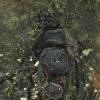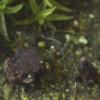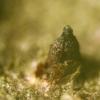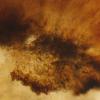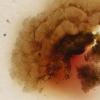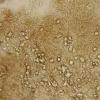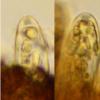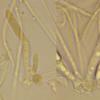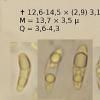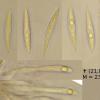
22-12-2025 00:47
Patrice TANCHAUDBonsoir, récolte à proximité du milieu dunaire

21-12-2025 21:32
Pol DebaenstHello, Garden, Burgweg 19, Veurne, BelgiumOn 10/1

21-12-2025 21:40
Isabelle CharissouBonjour, j'aimerais connaitre les références de

21-12-2025 21:31
Pol DebaenstHello, Garden, Burgweg 19, Veurne, BelgiumOn 10/1

21-12-2025 21:31
Pol DebaenstHello, Garden, Burgweg 19, Veurne, BelgiumOn 10/1

20-12-2025 23:08
Patrice TANCHAUDBonsoir, récolte sur sol sablonneux dans l'arri�

21-12-2025 09:32
Hello.A tiny ascomycete found embedded in wood in

20-12-2025 15:47
Mirek GrycHi.These grew on pine wood that was heavily covere
Dermea padi?
Viktorie Halasu,
09-07-2017 01:27
 Hello forum,
Hello forum,this week I found this Dermea on bark of Prunus padus trunk (partly broken but still alive). This one has rather different spores from D. prunastri, but I didn't find any illustration of spores of D. padi in my literature. Nauta & Spooner (2000) give spore length as 15-20 um for D. padi - is that real size, or maybe a result of mixed literary data? (Zotto wrote here earlier, that the concepts of D. padi and D. prunastri might be interchanged in some works.) Can I call it D. padi or another name?
Thank you in advance for any advice.
Viktorie
Hans-Otto Baral,
09-07-2017 07:35

Re : Dermea padi?
Hi Viktorie
This is actually what I call D. padi. D. prunastri on Prunus spinosa has narrower, always distinctly curved conidia.
Conidial width varies between *3.5-4 and *4.5-5 µm among my pics, and yours are with 3-3.5 at the very low end.
Yes it is with croziers.
Zotto
This is actually what I call D. padi. D. prunastri on Prunus spinosa has narrower, always distinctly curved conidia.
Conidial width varies between *3.5-4 and *4.5-5 µm among my pics, and yours are with 3-3.5 at the very low end.
Yes it is with croziers.
Zotto
Viktorie Halasu,
09-07-2017 12:19

Re : Dermea padi?
Hello Zotto,
thank you for confirmation.
Viktorie
thank you for confirmation.
Viktorie

